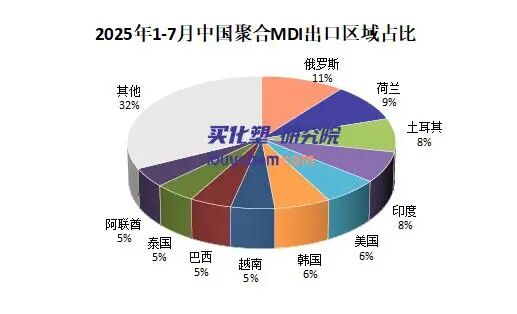511% Sky-High Tariff Backfires on United States, Wanhua Chemical Faces Anti-Dumping Measures
Recently, the U.S. Department of Commerce announced the affirmative preliminary ruling in the anti-dumping investigation of diphenylmethane diisocyanate (MDI) originating from China (including polymeric MDI, pure MDI, and modified MDI), determining that the highest dumping margin for Chinese companies reaches an astonishing 511.75%, with the preliminary tax rate for industry leader Wanhua Chemical set at 376.12%.

The present investigation originates from February 12, 2025, when the specially established MDI Fair Trade Alliance in the United States, whose core members include chemical giants BASF and Dow, formally filed an application. The alliance accused Chinese MDI products of being sold in the U.S. market at unfairly low prices, causing substantial harm to the domestic industry.
The United States has always been a major export market for China's MDI. However, in the past three years, China's exports of pure MDI to the U.S. have plummeted sharply, from 4,700 tons and $21 million in 2022 to 1,700 tons and $500,000 in 2024. The export volumes of polymeric MDI were 225,600 tons, 230,200 tons, and 268,000 tons, with transaction amounts of $473 million, $319 million, and $392 million respectively. Although the export volume of polymeric MDI has maintained a certain scale, the transaction amounts have shown significant fluctuations, indicating signs of price pressure.
In the first half of 2025, with the dual pressure of anti-dumping and tariff policies, American domestic companies began seeking new supply systems, leading to a significant decline in the export volume of polymeric MDI from China to the United States. From the export data of the first seven months of this year, Russia has emerged as the top export destination with 50,300 tons, while the United States has fallen to fifth place.

If the U.S. Department of Commerce makes an affirmative final ruling in the future, it will have a certain impact on China's major MDI manufacturers, but the actual impact is expected to be relatively limited. At that time, production facilities in countries like South Korea, including BASF Korea and Kumho Mitsui, are expected to increase their export efforts to the U.S. market. This move will lead to a tightening of MDI supply within the Asia-Pacific region. As the world's largest MDI manufacturer, Wanhua Chemical can leverage its high-quality and stable products to quickly fill the supply gap in the Asia-Pacific region, achieving a "rebalancing" of the market.
Secondly, the global capacity layout of Chinese enterprises has become a "buffer." Taking Wanhua Chemical as an example, it not only has a substantial production capacity in China but also has acquired and invested in BorsodChem in Hungary, which has an annual MDI capacity of 400,000 tons. This European base can flexibly adjust the supply chain and increase exports to the United States, effectively hedging against the high tariff barriers that domestic products in China may face.
The recent U.S. anti-dumping investigation into Chinese MDI is a typical reflection of the rising global trade protectionism. By imposing high tariffs to create barriers, the intention is to protect domestic producers in the short term and encourage the reshoring of manufacturing. However, in today's deeply intertwined global economy, especially in the oligopolistic, capital and technology-intensive MDI industry, such a "blocking" strategy may be unlikely to achieve its ultimate goal. It will increase the raw material costs for the U.S. downstream manufacturing sector, weaken the competitiveness of its end products, and ultimately, the cost will be borne by American consumers.
The extremely high tariffs proposed by the U.S. appear to be a trade ruling on the surface, but on a deeper level, they reflect the strong anxiety of the United States over having a "self-reliant and controllable" key basic chemical industry chain, as well as the competitive pressure faced by its traditional giants when confronted with China's powerful and efficient supply chain.
【Copyright and Disclaimer】The above information is collected and organized by PlastMatch. The copyright belongs to the original author. This article is reprinted for the purpose of providing more information, and it does not imply that PlastMatch endorses the views expressed in the article or guarantees its accuracy. If there are any errors in the source attribution or if your legitimate rights have been infringed, please contact us, and we will promptly correct or remove the content. If other media, websites, or individuals use the aforementioned content, they must clearly indicate the original source and origin of the work and assume legal responsibility on their own.
Most Popular
-

Zf asia-pacific innovation day: Multiple Cutting-Edge Technologies Launch, Leading Intelligent Electric Mobility
-

Mexico officially imposes tariffs on 1,400 chinese products, with rates up to 50%
-

Fire at Sinopec Quanzhou Petrochemical Company: 7 Injured
-

List Released! Mexico Announces 50% Tariff On 1,371 China Product Categories
-

Argentina Terminates Anti-Dumping Duties on Chinese PVC Profiles! Kingfa Technology & Siemens Sign Digital and Low-Carbon Cooperation Agreement






